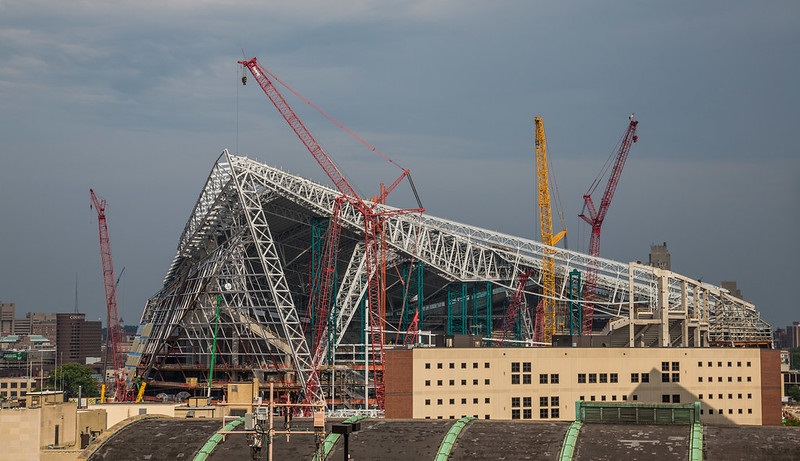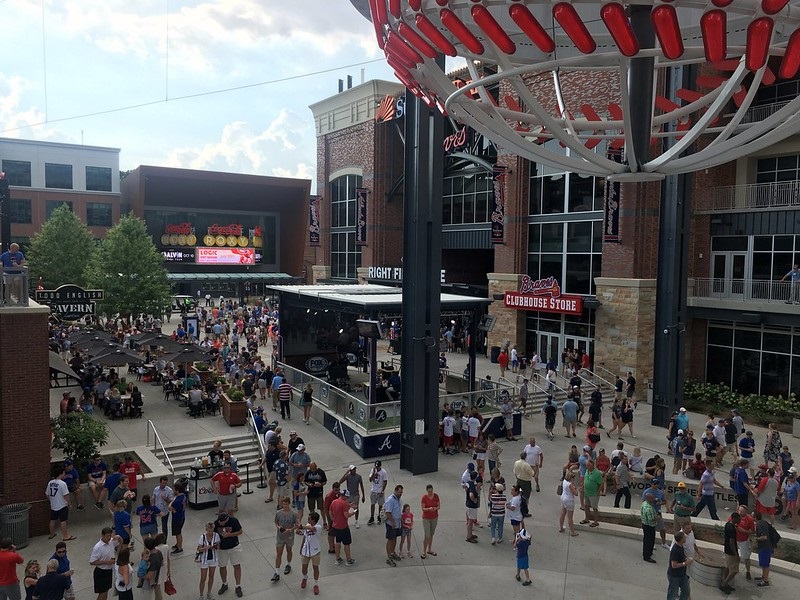
U.S. Bank Stadium - Minnesota Vikings
Image Credit: Tony Webster (CC BY 2.0)
The Washington Examiner wrote an article yesterday that called for the end of the usage of public dollars to build stadiums and arenas for sports teams. The popular newspaper cited the Brookings Institution which determined that 36 stadiums have been constructed since 2000 that have cost federal taxpayers $3.2 Billion. The article was inspired by a recent bipartisan bill that aims to keep taxpayer dollars from being used to build new stadiums for professional sports franchises and their billionaire owners. The bill is being championed by Senators Cory Booker (D) of New Jersey and James Lankford (R) of Oklahoma.
Here’s the stadium scenario that has been playing out over the last several years and it’s getting worse. Let’s say one billionaire owner wants a new stadium for their team that is equipped with the latest bells and whistles; club and luxury seating, a mixed-use development outside of the venue, new scoreboard and ribbon boards, the whole nine. It doesn’t matter that the team’s current stadium is in perfect condition. The team’s owners will then submit a request for taxpayer dollars via municipal bonds, hotel taxes, half-cent sales tax increases, whatever they can come up with, to help pay for the construction of the stadium. The city will ultimately own the stadium and the team will sign a lease with the city’s stadium authority and pay them rent. Rent is usually in the neighborhood of $1-$5 million per year. The team and venue will then often sell the stadium’s naming rights to a corporate partner and make even more money.
But what if the city doesn’t have the money to build a new stadium? What if the city has the money and refuses to fund a new stadium project? Then the owner bolts to a city that will and takes the team with them. St. Louis, Missouri recently lost the Rams to Los Angeles, California after the city was unable to get a new stadium built for the Rams and owner Stan Kroenke. Oakland, California just lost the Raiders to Las Vegas, Nevada. Charlotte, North Carolina lost the original Hornets to New Orleans, Louisiana. Sacramento, California almost lost the Kings to Seattle, Washington until the city was able to generate the funding to build the brand new Golden 1 Center. Situations like these are arguably a no-win hostage situation for the city and an easy win for the team’s ownership. Calgary, Alberta (Calgary Flames), Tampa, Florida (Tampa Bay Rays) and Oakland, California (Oakland Athletics) currently have their backs up against the wall in regards to building new stadiums for their teams.
According to the Washington Examiner, team owners are aware of the political pressure local politicians are under to make sure teams don’t relocate to other cities. In 1986, under President Ronald Reagan, there was an effort to curb the amount of federal dollars available to build stadiums for sports teams. 1986 was the last time our country experienced major tax reform.
Unfortunately, we’re also seeing a lot of “keeping up with the Joneses” in professional sports. When one team builds a new stadium with a certain feature, the other teams immediately try to copy the same feature or go even bigger. It’s no coincidence that the New York Yankees and New York Mets debuted at their new stadiums during the exact same year (2009). It’s no coincidence that the New York Giants built a stadium even larger than AT&T Stadium (home of the Dallas Cowboys) a year later. It’s no coincidence that the Dallas Cowboys built a massive scoreboard at AT&T Stadium only to be outdone by the Houston Texans and NRG Stadium a few years later.

The Battery Atlanta, SunTrust Park, Atlanta Braves
Image Credit: David Jones (CC BY 2.0)
A new trend is for owners to request mixed-use developments to be erected outside of these newly built stadiums. Mixed-use developments are neighborhoods that offer lodging, retail shops, bars and restaurants. The Chicago Cubs were the team that originally set the standard with these types of neighborhoods with the way the team helped shape Wrigleyville. The Detroit Red Wings, Milwaukee Bucks and Texas Rangers are all now building mixed-use developments outside of their new stadiums.
With the United States now $20 trillion in debt, we’re glad to see efforts like this bipartisan bill that call for more financial responsibility with the use of federal tax dollars. New stadium deals become especially problematic when a city has less than stellar public schools and infrastructure. However, we’re still skeptical that any drastic changes will take place any time soon.
Related Articles
- St. Petersburg, Florida wants to Build a New Ballpark for the Tampa Bay Rays
- Los Angeles Rams to Construct new Stadium in Inglewood, California
- Texas Rangers and City of Arlington reach Agreement on Funding for new Ballpark
- New York Yankees have lost $166 Million in Ticket Revenue since Opening at Yankee Stadium in 2009
- The Washington Redskins are Searching for a Site for their New Stadium
- Most Expensive Naming Rights Deals for Major League Ballparks

